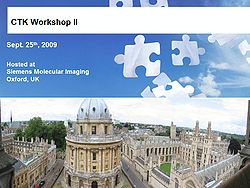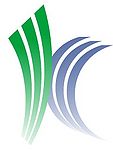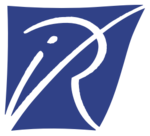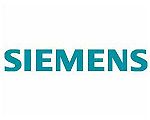Difference between revisions of "Events:CTK-Workshop-September-2009"
| Line 35: | Line 35: | ||
=Minutes= | =Minutes= | ||
| − | * | + | ==Introduction== |
| − | * | + | *GP introduces the meeting agenda and briefly summarizes the main conclusions reached in Heidelrberg meeting |
| + | *Board appoint RK as meeting Chair and MV as minuting secretary. | ||
| + | *GP we should look at FNIH for sustain to the CTK initiative | ||
| + | **Seminal money can create a collective identity for the CTK consortium | ||
| + | **MV we need to design this as a non unique initiative so that if similar opportunities arise in Europe or elsewhere we can catch them | ||
| + | **SA we should copy Insight consortium by limiting the possibility for this ID to go for funding. | ||
| + | *When do we open up? Balance between the need to build a vision and the grass nature | ||
| + | *Web page up and running SA take lead on it | ||
| + | *MV add a public statement on how the CTK initiative has formed and how it is evolving | ||
| + | *RK and MV are requested to draft a statement that recognise the pro tempore nature of group, set to 12 months its horizon, and post-pone any newcomer to then | ||
| + | *GP will follow-up FNIH idea | ||
| + | *RK proposes to have next meeting in RSNA 2009 29-11 through 4-12 Chicago. LT will check with the organization for the logistics. | ||
| + | *Another meeting could be done in SPIE medical imaging 13 - 18 February 2010 San Diego, California, USA. CK will explore this possibility and report to the group. | ||
| − | GP | + | ==Architecture brainstorm== |
| + | *LT discuss the DICOM support with CTK (DCMTK vs DCM4CHE) and in general the problem if using non C++ libraries and services to deal with ancillary functions. | ||
| + | *Discussion moves to the issue of DCMTK and its plans with respect to the vision of a full DICOM/PACS implementations | ||
| + | *MO gives and OFFIS presentation. | ||
| + | *GP request that image data read by DCMTK can be stored into an existing buffer defined by the calling application | ||
| + | *LT request that image processing module is designed to create the look-up table that can be applied on the raw data into the caller application. | ||
| + | *CTK group could become an advisory / specification body for the various teams developing the various frameworks. This includes the possibility to create a repository of benchmarking datasets for I/O compliance and algorithmic testing. | ||
| + | *MV asks for extension of DCM Standards toward image processing and image-based modelling data types with respect to DCMTK development plans. MO recognise the importance of this aspect, but express concern that the OFFIS group can tackle this alone, suggesting that this aspect is taken as CTK goal. | ||
| + | *SA inform of a NLM meeting on the next round for ITK v4, where its has been discussed the possibility to support the further development of DCMTK as dicom library for ITK. | ||
| − | + | ==Data Structures and Scene Graphs== | |
| − | + | *Data object model emerge from the discussion on how ITK can be used as part of the CTK effort. The problem is clearly open and so far not unique solution appears to establish. Further discussion is required. | |
| − | |||
| − | |||
| − | |||
| − | |||
| − | |||
| − | |||
| − | |||
| − | |||
| − | |||
| − | |||
| − | |||
| − | |||
| − | |||
| − | |||
| − | |||
| − | |||
| − | |||
| − | |||
| − | |||
| − | |||
| − | |||
| − | |||
| − | |||
| − | |||
| − | |||
| − | |||
| − | |||
| − | |||
| − | |||
| − | |||
| − | |||
| − | |||
| − | |||
| − | |||
| − | |||
| − | |||
| − | |||
| − | |||
| − | |||
| − | |||
| − | |||
| − | |||
| − | |||
| − | |||
| − | |||
| − | |||
| − | |||
| − | |||
| − | |||
| − | |||
| − | |||
| − | |||
| − | |||
| − | |||
| − | |||
| − | |||
| − | |||
| − | |||
| − | Data object model emerge from the discussion on how ITK can be used as part of the CTK effort. The problem is clearly open and so far not unique solution appears to establish. Further discussion is required. | ||
Revision as of 13:27, 25 September 2009
Home < Events:CTK-Workshop-September-2009The Common Toolkit Workshop at Siemens Molecular Imaging in Oxford, UK
September 25 2009
| The purpose of this meeting is to convene a number of groups who are working on FOSS Medical Image Computing platform development using BSD style licenses and to explore meaningful ways of coordination and integration. This follows a two-day initial meeting in June.
CTK is a pro-tempore group of like minded technically oriented softare tool builders. We expect to release a first version of CTK within a year. If you are interested to learn more, please contact Hans Peter Meinzer or Ron Kikinis. |
Links
- http://www.CommonTk.org (under development - reserved as future home page)
- http://my-trac.assembla.com/protoctk Prototype trac installation for CTK hosted by assembla.com.
Schedule
THURSDAY, SEPT. 24th
- Guests arrive at the Barcelo Hotel. CTK attendees are offered a discounted rate of £88.00 per night including breakfast.
- 20.00-21.30: Private Dining at Barcelo Hotel
FRIDAY, SEPT. 25th
- Relocation from Hotel: 09.00AM
- 09.30-10.00 Introductions
- 10.00-11.00: Architecture
- 11.00-12.00: Dicom: DCMTK
- 12.00-13.00: Lunch at Siemens
- 13.00-14.00: Data Structures
- 14.00-15.00: Scene Graphs
- 15.00-15.15: Break
- 15.15-17.00: Widgets
- 17.00-18.00: Action Items
- 18.00-19.30: Brief tour of Oxford landmarks, followed by drinks at the Turf Tavern
- 19.30-21.30: Dinner at The Living Room restaurant
- Relocation to hotel
Detailed Agenda
Minutes
Introduction
- GP introduces the meeting agenda and briefly summarizes the main conclusions reached in Heidelrberg meeting
- Board appoint RK as meeting Chair and MV as minuting secretary.
- GP we should look at FNIH for sustain to the CTK initiative
- Seminal money can create a collective identity for the CTK consortium
- MV we need to design this as a non unique initiative so that if similar opportunities arise in Europe or elsewhere we can catch them
- SA we should copy Insight consortium by limiting the possibility for this ID to go for funding.
- When do we open up? Balance between the need to build a vision and the grass nature
- Web page up and running SA take lead on it
- MV add a public statement on how the CTK initiative has formed and how it is evolving
- RK and MV are requested to draft a statement that recognise the pro tempore nature of group, set to 12 months its horizon, and post-pone any newcomer to then
- GP will follow-up FNIH idea
- RK proposes to have next meeting in RSNA 2009 29-11 through 4-12 Chicago. LT will check with the organization for the logistics.
- Another meeting could be done in SPIE medical imaging 13 - 18 February 2010 San Diego, California, USA. CK will explore this possibility and report to the group.
Architecture brainstorm
- LT discuss the DICOM support with CTK (DCMTK vs DCM4CHE) and in general the problem if using non C++ libraries and services to deal with ancillary functions.
- Discussion moves to the issue of DCMTK and its plans with respect to the vision of a full DICOM/PACS implementations
- MO gives and OFFIS presentation.
- GP request that image data read by DCMTK can be stored into an existing buffer defined by the calling application
- LT request that image processing module is designed to create the look-up table that can be applied on the raw data into the caller application.
- CTK group could become an advisory / specification body for the various teams developing the various frameworks. This includes the possibility to create a repository of benchmarking datasets for I/O compliance and algorithmic testing.
- MV asks for extension of DCM Standards toward image processing and image-based modelling data types with respect to DCMTK development plans. MO recognise the importance of this aspect, but express concern that the OFFIS group can tackle this alone, suggesting that this aspect is taken as CTK goal.
- SA inform of a NLM meeting on the next round for ITK v4, where its has been discussed the possibility to support the further development of DCMTK as dicom library for ITK.
Data Structures and Scene Graphs
- Data object model emerge from the discussion on how ITK can be used as part of the CTK effort. The problem is clearly open and so far not unique solution appears to establish. Further discussion is required.
WS suggest that a discussion point is on software processing (make, dashboard) and wrappers.
LT explain how WG23 is working to define a mechanism called “abstract multidimensional image model” for coping with different data representations.
SA proposes the possibility of developing as part of CTK database services that provide a unified presentation to some basic properties of each dataset.
Discussion follows on data objects models: there is a conflict between the need for extensibility and the generality
JW points the group to Aim@shape.net EU project developed a taxonomy.
INRIA group suggest that what CTK needs is not a concrete implementation of the DOM, but only a taxonomy of abstract data types, and the functions / methods that we associate to them. The idea is discussed extensively.
SP summarise: a common data model with services and methods that are toolkit independent, with façade classes that expose the abstract types according to the need to specific toolkit (VTK, ITK, etc.).
ACTION: JW will post on the wiki the table of abstract classes and associated methods they developed in INRIA, so that we can all see if there are gaps for other tooolkits
Participants
- Hans-Peter Meinzer, German Cancer Research Center, Heidelberg
- Marco Nolden, German Cancer Research Center, Heidelberg
- Ivo Wolf, Hochschule Mannheim, Institut für Medizinische Informatik, Mannheim
- Steve Pieper, Isomics, Cambridge
- Ron Kikinis, Harvard Medical School, Boston
- Kevin Cleary, Georgetown University, ISIS, Washington DC
- Lawrence Tarbox, Mallinckrodt Institute of Radiology, St.Louis
- Stephen Aylward, Kitware Inc., Clifton Park
- Marco Viceconti, Laboratorio di Tecnologia Medica, Bologna
- Michael Onken, OFFIS DICOM Team, Oldenburg
- Olivier Clatz, Sofia Antipolis, INRIA, Nice
- Julien Wintz, Sofia Antipolis, INRIA, Nice
- Pierre Fillard, Sofia Antipolis, INRIA, Nice
- Gianluca Paladini, Program Manager, Siemens Corporate Research, Princeton
Slides
September 25 2009
ITK, VTK, IGSTK, InfoVis, FARSIGHT, Maverick (Stephen Aylward)
Slicer3 (Ron Kikinis, Steve Pieper)
MedINRIA (Olivier Clatz, Julien Wintz)
OpenXIP Extensible Imaging Platform (Gianluca Paladini)
MAF3 (Paolo Quadrani)
MITK (Ivo Wolf, Marco Nolden)
Working Group 23 (Lawrence Tarbox)
IGSTK (Kevin Cleary)
DCMTK (OFFIS) (Michael Onken)









